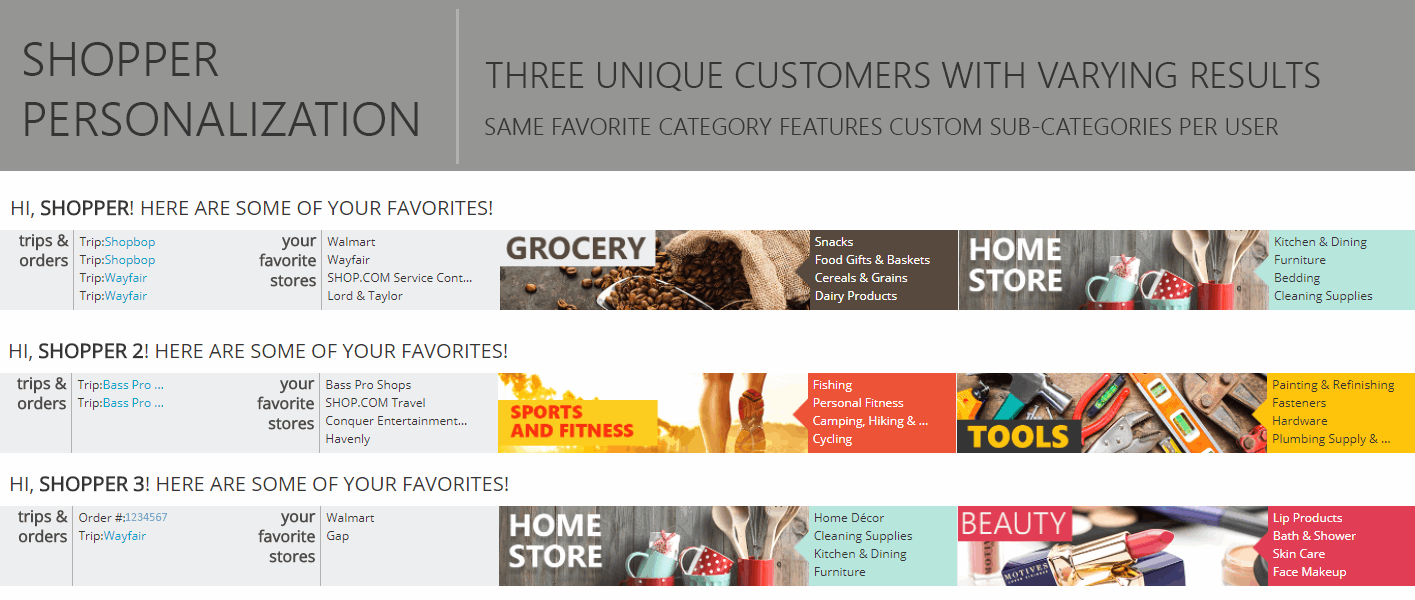Bridging The Gap Between Data And The UI
By Jon Vivers, SHOP.COM VP, Search & Analytics and Jessica Rice, Front-End Developer, SHOP.COM

From Google to Facebook, personal advertising is triggered based upon recently viewed websites, read articles, shared posts, and purchased items. The e-commerce marketplace is no exception. As time “is the most valuable commodity you have … and [consumers] then make that calculation a part of [their] financial everyday decision-making,” it is important to capture the consumer’s attention more quickly and efficiently — delivering goods and services they want and need immediately.
Online consumerism has dramatically increased over the last few years. As major brick-and-mortar stores close due to online retail growth, the need to provide more personalized online experiences is even more imperative. Shoppers have become increasingly tech savvy and reliant upon their digital devices, and they seek efficiency, independence and personalization when determining from which site they make their final purchases. While users are not interested in dealing with in-store sales associates, a good portion of “shoppers like a personal touch that reflects their history with a brand … and want product recommendations based on past purchases.”
SHOP.COM’s customer following is something of great value. The company’s data and analytics team has been gathering information over the past several years in an effort to better understand its customers’ preferences and favorite brands. The challenge with delivering relevant and effective personalization is two-fold:
- How does one determine the correct groupings of product and brand recommendations based upon a broad analysis of categorization and user preferences at an individual level?
- How does one deliver a compelling user experience based upon this data in a way that is meaningful and helpful to the customer?
Gathering User Data
SHOP.COM manages a diverse portfolio of customer-facing properties in multiple countries and languages, from its flagship comparison shopping service to the back office site for its UnFranchise® Owners, UnFranchise.com, with a plethora of brand-focused websites, mobile apps, and browser plugins.
Managing data of this scale and variety is a complex task and SHOP.COM uses multiple technologies to help control the flow of data. Its preferred tagging solution is Tealium, and onsite and in-app interactions are measured with Adobe Analytics. From there, data is cleaned and streamed to an on-premises data warehouse where it is combined with transactional data from ordering/registration systems before being analyzed in R, processed into actionable customer insights, and made available to client-facing systems via customer-engagement APIs.
Making Sense Of The Data
Some types of data require minimal processing to form part of the customer profile. For example, recent order history can be injected directly into the customer profile. Other data points require more processing. User preferences can be explicit or implicit, and discovering preferences that are predictive of future behavior is the key to a successful customer-engagement campaign. Finally, behavioral clustering can show relationships in the data that cannot easily be inferred. Making use of these insights in client-facing applications (such as search, recommendations, and merchandising) requires considering the customer as part of the query to those systems.
Customer-Minded Approach
Consumers shop where they feel comfortable and familiar with their surroundings, where they feel appreciated and have developed a rapport over a period of time. It is the same for online shopping. SHOP.COM is a company that values and cares deeply about its customers. Its development, marketing, and analytics teams work hand-in-hand to deliver shoppers a personal experience that is not only easy and efficient, but also makes customers feel at home.
 The company is actively working to engage customers as soon as they land on the home page. Through various campaigns, it highlights a shopper’s personal profile with recommendations based upon his or her most recent purchases, top search requests, and favorite stores. This enables the delivery of product, store, and brand recommendations that closely reflect an individual’s unique preferences in a way that feels organic and personal. When a shopper clicks on a recommendation, he or she begins a personal journey via specialized search results and associated product recommendations with only items that match personal buying habits without the need to filter or sort — it is already done for them.
The company is actively working to engage customers as soon as they land on the home page. Through various campaigns, it highlights a shopper’s personal profile with recommendations based upon his or her most recent purchases, top search requests, and favorite stores. This enables the delivery of product, store, and brand recommendations that closely reflect an individual’s unique preferences in a way that feels organic and personal. When a shopper clicks on a recommendation, he or she begins a personal journey via specialized search results and associated product recommendations with only items that match personal buying habits without the need to filter or sort — it is already done for them.
In addition to recommendations and custom search results, the company is beginning to develop a personalized customer page that will deliver content that pertains only to that shopper. The customer’s personal page will display his or her most frequented departments and subcategories, products, and recent orders, placing relevant content front and center. It will also provide information on recent order transactions; upcoming AutoShip orders; reminders to reorder frequently purchased consumer items; recent shopping lists; and marketing promotions specifically targeted toward favorite products, brands, and stores. This page will have a custom interface with imagery and interchangeable color schemes based upon the user’s preference that makes shopping a truly engaging experience.
The Next Level
While online retail has increased over the past years — more than 50 percent of consumers now purchasing online — many users still look for a more tangible and personal experience online purchasing often does not provide. Unified commerce has become popular, with stores such as Target, Walmart, and Macy’s offering users in-store pickup and exchanges and returns on items they have purchased.
SHOP.COM has established in-store pickup options, available with many of its Partner Stores in 10 global marketplaces, as well as partnerships with local service providers and restaurants through its SHOP Local program. Yet users are continually looking for even greater human interaction when it comes to making certain purchases. Online concierge services have started to fill a niche many traditional e-commerce sites do not offer, making it important to find a way to further bridge the gap between offline and online consumerism.
SHOP.COM was one of the first entirely online entities to provide personal SHOP Consultants for its customers and is now developing new ideas to take personal concierge services a step further. Branches of the company are being conceived to further expand white glove service in areas in which it already has expertise, such as personal care and beauty, clothing and trends, home décor, and groceries. The company is focusing on target groups to perform market research on early-adoption models to best determine areas from which its customer demographic is most interested and would benefit. The retailer is taking some of the current features already available on its site and honing them based on how users currently interact, in order to design a platform from which to build and expand upon new or existing service models.
It is an exciting time for online consumerism. With furthering dedication and focus toward customers, it will be fascinating to see what new technological advancements and changes occur for online retailers, bringing a more personal experience to online shopping.
About The Authors
Jon Vivers serves as Vice President, Search & Analytics at SHOP.COM. Mr. Vivers began his career with the company in 2005 as International Director. In 2006, Mr. Vivers was promoted to Senior Director of Merchant Engineering and remained in this role until August 2013, where he began his most current position with SHOP.COM. His many areas of expertise include E-commerce, Databases, Web Analytics, SEO, Business Intelligence and Machine Learning just to name a few. Mr. Vivers studied Mathematics at Glasgow University in the United Kingdom. He and his wife live in Monterey, California and most enjoy the time they spend together and with their family.
Jessica Rice is Front-End Developer at SHOP.COM. She blends her love of art and design with her drive for solving challenges. Her continued focus is on increasing user engagement through designing intuitive interfaces and then turning around to help design and build the front-end architecture so that the full vision is realized. When not on her computer, you can find her chasing after her son and the family German Shepherd, cooking up a new culinary adventure, or doing pretty much anything that is creative and inspired. Jessica is currently pursuing personalization from customer data as it pertains to unique customer interfaces to deliver more positive shopping experiences and purchases.
